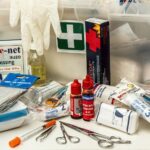How to ensure your restaurant is healthy.
Stressful commercial kitchen health inspection. can occur. Many restaurants fail to prepare for inspections, which is a normal part of the food service industry. It doesn’t have be this way. You can confidently face your next restaurant inspection by being proactive about food safety and creating a solid preparation program.
What should you expect?
Depending on the location of your business, you can expect at most two restaurant inspections per annum (or one every six months). Officials may be required to inspect a restaurant if they receive complaints from customers. This number could change.
It can be easy for people to forget and leave tasks unfinished. However, violations can lead to fines or even permanent closures. This can have a serious impact on your restaurant’s reputation and revenue. Remember that the goal of the health inspector is to ensure safety for your restaurant, staff, and customers. So be prepared to display your best qualities.
How to prepare
Inspections can occur at any moment. Therefore, it is important to treat every day like an inspection day. You should implement a HACCP plan (Hazard Analysis and Critical Control Points) and conduct self-inspection regularly. A HACCP can help you identify hazards. However, internal inspections will allow you to prepare your entire staff for the real deal. This will ensure that everyone has a safe and enjoyable dining experience.
Knowing exactly what inspectors want is the first step. There are many regulations that vary from one place to the next. It is important to consult your local health department to ensure you understand which standards are applicable to your restaurant. You can then inspect your restaurant yourself to identify and rectify any issues that may have been missed during an inspection.
How to do a self-inspection
Self-inspections should be treated as real inspections. This will allow you to nip problems in the bud more quickly and avoid complacency. Take a look at our example checklist to learn what you should be paying attention to.
NOTICE: This list is not complete. To ensure an accurate and thorough internal inspection, make sure to check your local guidelines.
Temperature control
Food that is not properly cooked or stored at dangerous temperatures can cause bacteria to build up and make people sick. Avoid the temperature danger zone, which is the range where bacteria grows fastest (40°F to 140°F). Conforming to FDA and USDA standards
- Keep cold food below 4°C/40°F
- Frosted food should not exceed -18degC/0degF
- Hot food should not exceed 60°C/140°F
- To ensure accuracy and the right temperature zone, check the thermometers of all refrigerators.
- Make sure meats are cooked at safe internal temperatures
- Verify that all meat thermometers work correctly.
Food storage
It is also important to know where and how your food is stored in order to prevent contamination.
- Make sure that cooked and ready-to eat food is kept above raw food
- Make sure food is not stored below six inches from the floor, on shelves, racks, or pallets.
- To avoid spillages or drips, make sure food is wrapped properly.
- To reduce the risk of having your hands touch prepared food, make sure you place your utensils in an appropriate area.
Hygiene for personal use
Everyone who handles food should adhere to hygiene protocols and standards to prevent contamination.
- You should ensure that there is a sink designated for handwashing. This sink must be stocked with soap, hot and cold water, and it shouldn’t be used for food preparation or dishwashing.
- Before and after handling food, ensure employees wash their hands with hot water for at least 20 seconds (>=38Cdeg/100degF).
- Single-use gloves should be available in the right sizes, and can be changed between tasks or if they become dirty or torn.
- Make sure food handlers have clean uniforms and aprons. Keep hair neatly trimmed.
- Employees should maintain their nails at the right length and cover any cuts or injuries.
Contact with food
Food contact can cause food poisoning.
- Regularly clean all food preparation/contact surfaces with soap, water, and an approved sanitizer.
- You should inspect your utensils for cracks or damage that could lead to contamination.
- Wash dishes, utensils and other equipment regularly using either:
- FDA approved a two- or three-sink dishwashing system (wash, rinse and sanitize).
A mechanical dishwasher.
- Make sure you check the ice machine/bin regularly and make sure it is being emptied and cleaned with regular deep cleaning at least twice a year.
- Non-food contact surfaces/equipment
- It doesn’t have to come in direct contact with food, but that doesn’t mean it shouldn’t be cleaned.
- Check that all floors, walls, and ceilings are in good condition.
- You should ensure that all non-food contact equipment such as ventilation and dishwashers are in good working order.
Public/staff bathrooms
All restrooms must be clean and kept clean, regardless of whether they are used by guests or employees.
- Make sure bathrooms are regularly cleaned from top to bottom – floors, walls, ceilings included!
- You should ensure that every bathroom has toilet paper, a trash receptacle and hot/cold water.
Removing and storing waste
Restaurants create a lot of waste. It is important to know where, when and how it goes.
- All waste containers should be leak-proof, pestproof, and non-absorbent.
- Make sure that all liquid and solid waste are removed from food preparation areas at least once per day.
Pest control
Despite the fact that pests are not something you want in a restaurant, they may be able to get in with all the food.
- You should inspect for evidence of pests such as droppings and nesting areas.
- You should eliminate any food or water that is easily accessible, and also look for entry points into walls and doors.
- Use pest-control techniques that aren’t poisonous or chemical, such as glue traps, to control pests in food preparation areas.
- You should sign a contract with licensed pest-control operators.
Knowledge of the floor by staff
Your entire staff should be aware of the importance and safety of food. The more they can self-regulate and keep things in order, the better prepared they will be to answer inspectors’ questions.
- Ensure that all staff are certified and trained according to local health department requirements.
- Ask employees questions about safety and sanitation at work.
- Servers are important to remember. They need to know how to hold glasses and plates to prevent contamination.
NOTE: Follow up with employees after any inspection, whether internal or external. This will allow you to resolve questions or train staff as needed.
Recordings
You should keep track of your food safety practices, just as you keep track of sales and stock daily.
- Make sure you keep up-to-date and organized records
- All inspections, internal and external.
- HACCP is a food safety program that includes training and procedures for food safety.
- Pest control schedules
- Repair and maintenance of equipment
Although surprise inspections can be stressful and can cause stress, you can make sure that your staff and yourself are ready to face the next health inspector. You’re also investing in a shining reputation that will keep diners returning to your restaurant.
Related Articles:
https://www.dailyhealthstudy.com/how-to-prepare-for-a-health-inspection
https://www.finalcooking.com/9-tips-for-restaurant-health-inspections
https://www.whattodiet.com/survive-your-next-health-inspection
https://www.foodandfoodtrips.com/commercial-kitchen-health-inspection
https://www.guidehealth.us/how-to-prepare-for-a-health-inspection
https://www.finalhealth.us/six-secrets-to-ace-restaurant-health-inspections
https://www.healthable.us/how-to-pass-a-restaurant-health-inspection
https://www.wayhealth.us/how-to-prepare-for-a-health-inspection-at-a-restaurant
https://www.advisorhealth.us/your-business-could-be-saved-by-your-health-inspector





